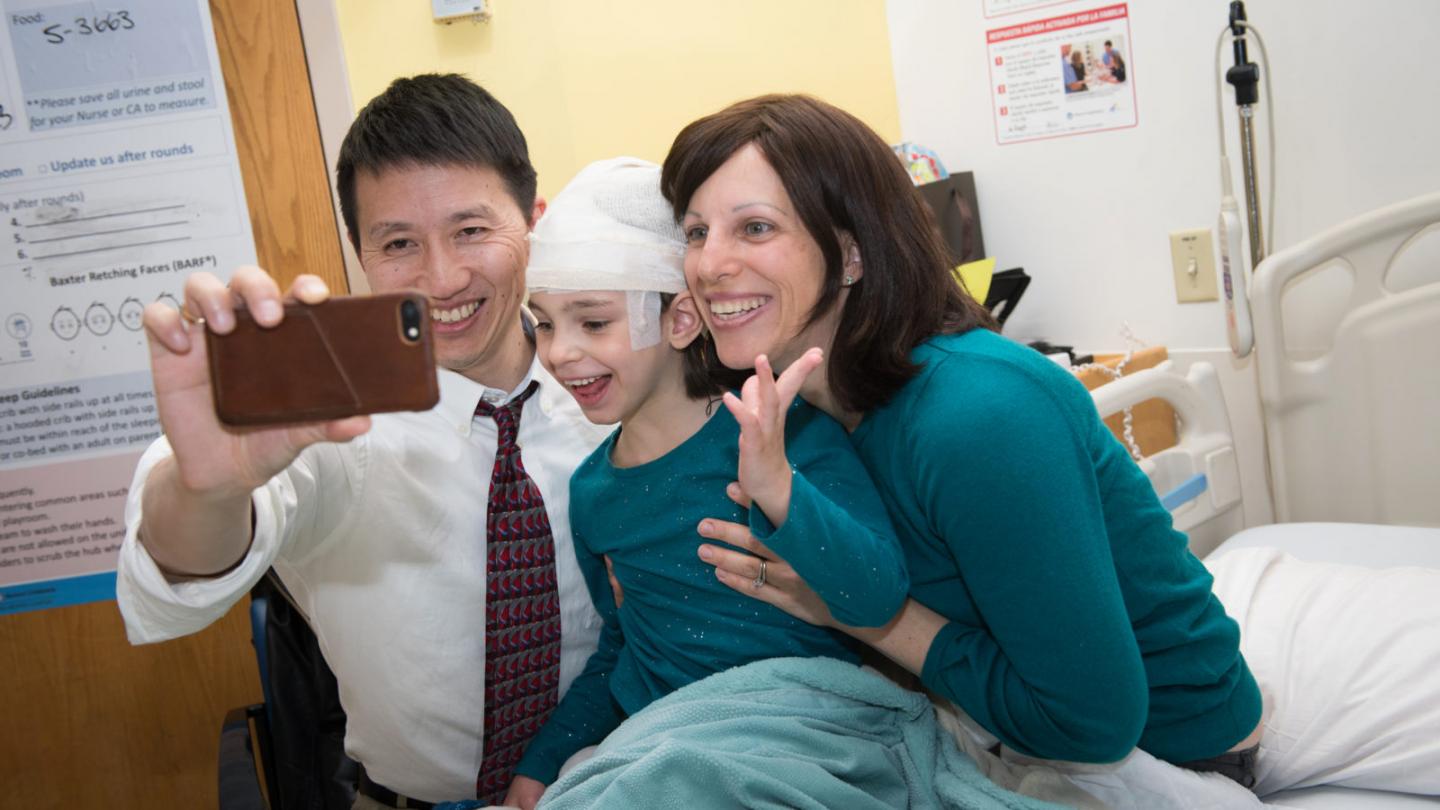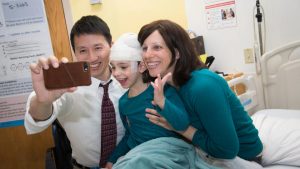Customized Oligonucleotides Treat Seizures in Child with CLN7 Disease in Record Time
Written by |

Timothy Yu taking a selfie with Mila and her mother, Julia. (Photo courtesy of Boston Children's Hospital)
Neurologists and researchers have tailor-made an antisense oligonucleotide therapy (ASO) for a 6-year-old girl who has CLN7 Batten disease, and it cut to half her number of daily seizures and reduced by more than 80% how long each seizure lasted.
The therapy was developed at Boston Children’s Hospital and has been heralded as an unprecedented example of personalized medicine for a rare condition.
Researchers identified the patient’s unique mutation, designed a customized treatment, manufactured and obtained permission from the U.S. Food and Drug Administration (FDA) to begin treating the patient, all in less than one year.
The findings are detailed in the study “Patient-Customized Oligonucleotide Therapy for a Rare Genetic Disease,” published recently in the New England Journal of Medicine.
“One of the unique things about this trial is that, due to clinical urgency, we were starting a first-in-human trial with a drug that had only been tested in our patient’s cells in a dish,” the study’s senior leader, Timothy Yu, MD, PhD, said in a press release. Yu is a neurologist and genetics researcher at Boston Children’s Hospital. “What was also unique is that we have a drug that is targeted to a mutation seen to this date only in one patient.”
Mila’s parents started to worry about their child’s condition when she was 3 years old and her right foot began to turn inward. At age 5, she came to medical attention because of modest language and social regression, as well as increased clumsiness and stumbling. Her condition begun to worsen rapidly.
When first seen at Boston Children’s Hospital at age 6, she was blind, was starting to have seizures, lost almost all her speech and had general neurologic and developmental regression. A 24-hour electroencephalography (EEG) exam revealed she also had several subclinical generalized seizures.
A skin biopsy and genetic testing strongly suggested CLN7 disease, but one of the underlying mutations was missing.
CLN7 disease is caused by mutations in the MFSD8 gene, which leads to the production of a defective protein. This affects the ability of cells to purge waste products, leading to a build-up of substances that are toxic to tissues, especially nerve cells.
This is believed to underlie the neurological signs and symptoms that mark the condition, including seizures and vision loss.
The disease is inherited in an autosomal recessive manner, meaning that those affected inherit two mutated copies of the gene, one from each parent.
One of Mila’s mutations (from her father) was a known Batten disease mutation, but the mutation from her mother could not be found.
Searching for help
Mila’s mother reached out on Facebook, looking for a lab willing to do whole genome sequencing (WGS) — the process of determining the complete genetic sequence of an organism. The post eventually reached Yu, who decided to take the case.
In April 2017, Yu and his team finally pinpointed the missing mutation, which was hidden in a part of the genome that is not often analyzed.
This mutation affected a piece of the MFSD8 gene that controls the way cells produce mRNA molecules (templates used by cells to produce proteins from a given gene). Before they can be read by the protein-making machinery, however, mRNAs need to be modified in a process called splicing.
Mila’s mutation interrupted splicing and introduced a unique “stop” signal, which caused her cells to produce a shorter-than-normal version of the MFSD8 protein.
Researchers saw in this unique mutation an opportunity to tackle the disease using a mechanism of action and route of delivery identical to a medicine approved for children with spinal muscular atrophy (SMA) — Spinraza (nursinersen, developed by Biogen).
The approach consisted on designed a series of so-called antisense oligonucleotides (ASO) to bypass the splicing defect. These consist of short pieces of modified DNA made in the lab that were designed to home in on the MFSD8 gene and cover up the erroneous “stop” signal.
This would work as a Band-Aid that would allow the splicing machinery to read through the “stop” sequence and produce a full-length mRNA just like the one that would be made normally and give rise to a normal protein.
Using cells collected from the child, Yu’s team selected the best candidate ASO that could repair the splicing defect and correct the lysosomal abnormalities found in the child’s cells. They named their best candidate “milasen.”
In January 2018, the FDA granted permission to test milasen as a Single-Patient Compassionate-Use Investigational New Drug. The trial began Jan. 31, 2018.
The child received nine escalating doses of milasen — starting at 3.5 mg and increasing approximately every two weeks up to 42 mg — given by spinal injections (intrathecally) to enter the spinal canal and target the treatment to the brain. Since then, she has received maintenance treatments every two to three months, starting in August 2018.
Since the treatment began, the disease has slowed or stabilized. Seizure frequency has decreased from 15–30 seizures daily to between 0–20 per day; seizure duration decreased from one to two minutes to usually just a few seconds each.
“Over the course of treatment to date, milasen appears to have had an acceptable side-effect profile, with no safety concerns,” researchers wrote. Over the first year of treatment, no significant adverse changes were observed in vital signs, on strength, gait, and sensory testing, or in clinical lab test profiles.
The start of something big
Milasen itself remains an investigational treatment and is not suited for the treatment of other patients with Batten’s. But it could kick-off a revolution in how these and other rare genetic conditions are treated.
“This study offers a possible template for the rapid development of patient-customized treatments,” researchers wrote.
“Everyone knows that the future of precision medicine in pediatrics is developing treatments for kids one at a time, the way this work has done. But until now no one had a real-life case where everything lined up in a way to allow them to do it,” said Christopher A. Walsh, MD, PhD, chief of the Division of Genetics at Boston Children’s Hospital.
Yu believes that many other cases might be treated with a similar strategy. He and Mila’s mother met recently with the FDA to discuss a new regulatory model that offers custom ASO treatments for patients with rare or unique conditions.
“There are whole categories of diseases with populations too small to attract industry effort,” Yu said. “But in the hospital where research is a major focus, we can go one step, one patient, at a time. I think that some of the most exciting parts in science are when you try to do something new, when there isn’t a recipe.”
This study was funded by Mila’s Miracle Foundation — the non-profit started in 2016 to help treat the girl, the Mooney Family Fund, and other academic institutions.





